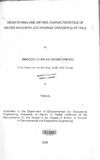| dc.description.abstract | Water hyacinth has become a sort of menace in several lakes, rivers and dams
in Africa, especially Kenya. This has lead to the accumulation of large mounts
with high moisture content and very low drying rates; hence there is a need to
investigate the behaviour of water hyacinth subjected to a two stage process
comprising of dewatering and drying so as to provide data that would influence
design of suitable dewatering and drying equipment for water hyacinth.
The broad objective of the study was to identify and relate the parameters that
are important in dewatering and drying of water hyacinth petiole. This involved
identification of the pertinent properties that influence dewatering and drying of
water hyacinth petiole and then developing predictive empirical equations for the
identified factors. Field work involved collection of samples from four different
locations within Nairobi dam. The experimental design enabled a series of
experiments to be carried out using a triaxial system to obtain the dewatering
data and behaviour of the stress versus strain rate curves, while drying was done
using a standard oven to obtain the drying data and the subsequent drying
curves.
Properties of water hyacinth petiole thought to be pertinent to dewatering and
drying characteristics were identified and mathematical predictive equations
developed from them. The relationship between deviatoric stress (q) and rate of
expelled fluid (w) had a general upward exponential trend. Power series was
utilized to model the behaviour of deviatoric stress versus strain rate depicting
decreasing strain rates during dewatering.
The average moisture content of fresh water hyacinth petiole was 91% wet basis.
Mean volume of expelled fluid during dewatering was 20.66 ml (SO = 3.5, n = 16)
as at the point of sample failure. Lowest strain rate at which deviatoric stress
began to accumulate in the sample was around 1.2 n', while the highest was 1.5
n:'. Mean deviatoric stresses required for expelled fluid to be realised were 20.85,
34.90, 29.75 and 28.19 kPa at confining stresses 300, 400, 500 and 600 kpa.
Respective standard deviations were 4.33, 5.09, 7.90 and 2.82 kPa. Mean drying
rate constant -(kmean) derived from the experimental data was used to develop
predictive equation that adequately described the effect of varying both drying
temperature and moisture content, on time, of samples during the drying
process. kmean was found to be 2.22, 2.71 and 3.39 n:' for oven drying
temperatures of 105, 130 and 150°C respectively. It was evident that increasing
the drying temperature resulted in an increase in drying rate whereas a change in
the moisture content of the sample before drying, did not affect the drying rate at
a constant drying temperature with a P-value of 0.97 at a significance level of
0.05.
Statistical investigation showed that there was no significant difference in the
means of the initial moisture content (P-value=0.94) for the samples collected at
the four locations within Nairobi dam. The comparison between deviatoric stress
and both rates of expelled fluid and strain rates further indicated that the
predictive equations described both dewatering and drying characteristics of the
samples accurately, with P-values above 0.50), for the range of identified
pertinent parameters.
The results of this research work will be useful in the design of suitable
dewatering and drying equipment, as a means of solving the problems caused by
high moisture content when handling and processing water hyacinth petiole as a
resource. | en |

